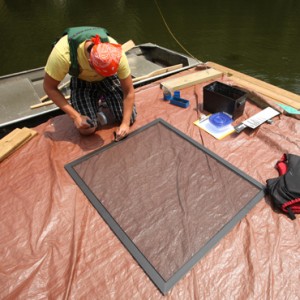No cats were killed in the writing of this blog
To you, it may be a humble pontoon boat, but to the scientists involved, it’s a research vessel and deserving of a worthy scientific name. Accordingly, the College’s new pontoon boat—I mean research vessel—will be known as RV Schrödinger’s Catamaran.

Patrick Cunningham, a summer REU student from Moravian College, marks screens on the work platform of the Matoaka algae flume. Behind Patrick is the johnboat used to access the flume from the Keck Lab dock. The RV Schrödinger’s Catamaran will replace both the johnboat and the platform on the York River flume when it is deployed.
The name is a reference to Shrödinger’s Cat, a thought experiment that involves a sealed, windowless box containing a number of things. There’s a gizmo that emits a subatomic particle every now and then, a Geiger counter, a container of poison gas…and a cat. If the Geiger counter perceives the presence of a particle emitted by the gizmo, it trips a lever that releases the poison gas, killing the cat.
Now here’s the question: Is the cat alive or dead? There’s no way of knowing when the subatomic particle will be released. Could be seconds, could be days.
The answer is that, for the purposes of that portion of the universe outside the box, the cat in the box is both dead and alive. This is an obvious absurdity, of course. Schrödinger came up with the cat thing to illustrate how quantum mechanics provides for multiple simultaneous states of things, much like a cat that’s dead and alive at the same time.
(Disclaimers: 1. Don’t try this at home: It only works in the strange world of quantum dynamics and in thought experiments. 2. Keep in mind that Schrödinger’s Cat was thought up to make something that is really hard to explain just a bit easier to grasp. 3. I have never in my life explained Schrödinger’s Cat to the satisfaction of anyone. The scientists say that I gloss over the good parts and everyone else either gets hung up on the very idea of killing a cat or the concept that anything can be dead and alive at the same time.)
Schrödinger’s Catamaran emerged as the winning entry in a run-off vote for names of the new research vessel. Austin Ziltz, a grad student in physics, submitted the winning entry. The other two names in the run-off were RV Alga-Rhythm and RV Wave Function.
The boat will be used in a collaborative effort to investigate the possibilities of using wild algae to make biofuel. The runner-up names are science puns, just like Schrödinger’s Catamaran. If you don’t get the jokes, don’t look at me—I’m the guy who just massacred Schrödinger’s Cat.
The naming contest (and the boat itself) were the brainchildren of Karl Kuschner, a research scientist involved in the algae studies. This summer a team launched an algae-cultivation flume in Lake Matoaka. It consists of what Kuschner describes as a “forty-foot hole in the water” filled with substrate screens for the algae to grow on. At one end of the flume is a working platform, essentially a piece of square floating dock.
There’s another flume planned for the York River, and Kuschner’s idea was that a boat could serve double duty. “We put the equipment on it on shore, then motor it out,” he said. “We tie it to the experiment and use it as a work platform. When we are done, we go back in. So it is basically a ten-by-twelve flat surface. It has pontoons instead of the square plugs that we have out at Matoaka. It is a pontoon boat; a party boat.”
He means a research vessel, of course.




No comments.
Comments are currently closed. Comments are closed on all posts older than one year, and for those in our archive.